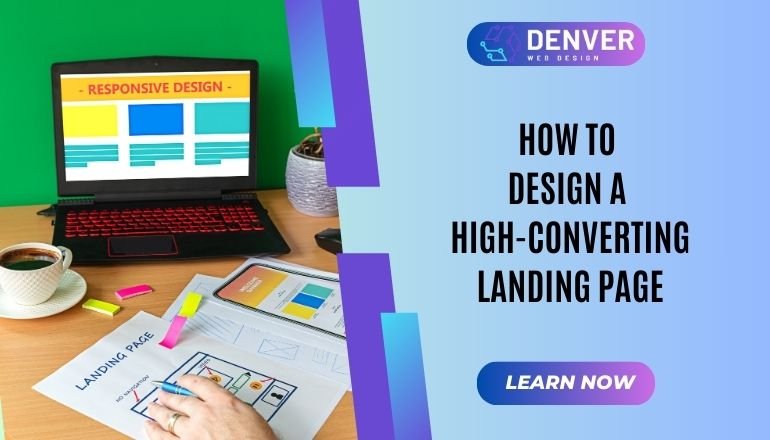
Landing pages are the cornerstone of successful online marketing campaigns. They serve as the entry point for potential customers and play a critical role in driving conversions. A well-designed landing page not only attracts visitors but also guides them toward taking specific actions, such as signing up for a newsletter, making a purchase, or downloading an e-book.
At Web Design Denver, we understand the art and science of crafting landing pages that convert.
What is a Landing Page?
A landing page is a standalone web page designed with a single goal in mind: to convert visitors into leads or customers. Unlike a typical website, which may have multiple purposes and navigation paths, a landing page focuses on one call-to-action (CTA).
Common goals for landing pages include:
- Capturing leads through a form.
- Driving sales or downloads.
- Promoting special offers or events.
Landing pages are often part of larger digital marketing strategies, including paid ads, email campaigns, or social media promotions.
Why is a High-Converting Landing Page Essential for Your Website?
Boosting Conversions
A high-converting landing page can significantly improve your marketing ROI. By focusing on a specific audience and goal, it minimizes distractions and maximizes the likelihood of action.
Enhancing User Experience (UX)
Landing pages are designed with simplicity and clarity, making it easier for visitors to understand your offer and take action.
Supporting SEO and Paid Campaigns
Landing pages optimized for SEO and PPC campaigns drive relevant traffic, improving your website’s visibility and conversion rates.
Building Trust and Credibility
Professional, well-designed landing pages establish trust with your audience, showcasing your brand as credible and reliable.
Key Features of a High-Converting Landing Page
- Clear and Compelling Headlines
The headline is the first thing visitors see. It should grab attention, communicate the value of your offer, and align with the ad or link that brought them there. - Strong Call-to-Action (CTA)
Your CTA should be prominently displayed and action-oriented. Phrases like “Get Started,” “Sign Up Now,” or “Claim Your Free Trial” are effective. - Visual Hierarchy and Design
Organize content in a way that naturally guides the visitor’s eye toward the CTA. Use contrast, whitespace, and images strategically. - Mobile-First Design
With mobile traffic accounting for a significant portion of web visits, responsive web design is essential. Your landing page should be optimized for all devices. - Social Proof and Trust Signals
Include testimonials, reviews, case studies, or trust badges to reassure visitors and reduce friction. - Minimal Navigation
Remove unnecessary links and navigation bars to keep visitors focused on the desired action. - Fast Loading Speed
Ensure your landing page loads quickly. Slow-loading pages can lead to higher bounce rates. - A/B Testing Capability
Test different elements such as headlines, CTAs, and imagery to find the version that converts the best.
Best Practices for Designing a High-Converting Landing Page
- Define Your Target Audience
Understand who you’re designing for. Tailor your messaging, visuals, and offer to resonate with your ideal customer. - Focus on a Single Goal
Keep your landing page simple and focused. Avoid trying to achieve multiple objectives with one page. - Use High-Quality Visuals
Incorporate professional images or videos that support your message and evoke emotion. - Leverage Analytics
Monitor performance metrics like bounce rate, time on page, and conversion rate to identify areas for improvement. - Optimize for SEO
Use relevant keywords like responsive web design, conversion rate optimization, and custom web design to improve search engine visibility.
Common Mistakes to Avoid
- Overloading with Information
Too much text or cluttered visuals can overwhelm visitors. Stick to concise, impactful messaging. - Generic CTAs
Vague or uninspiring CTAs like “Submit” can reduce conversions. Make them specific and benefit-focused. - Ignoring Mobile Users
A non-mobile-friendly landing page alienates a large portion of your audience. Use mobile-first design principles. - Slow Page Speeds
Every second of delay in loading can cost conversions. Regularly test and optimize performance. - Forgetting to Test and Iterate
Failing to test different elements leaves potential improvements undiscovered. Use tools like Google Optimize or Hotjar for A/B testing.
Conclusion: Key Takeaways
A high-converting landing page is a powerful tool for driving business growth. By focusing on a clear goal, optimizing for user experience, and implementing best practices, you can maximize your conversion rates and marketing ROI.
At Web Design Denver, we specialize in custom web design, website optimization, and conversion rate optimization (CRO) to help businesses succeed. Whether you need a landing page for a new campaign or a complete website redesign, we’ve got you covered.






